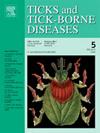2018-2023年欧洲疾病预防控制中心(ECDC)数据和国家公共监测报告中莱姆病神经螺旋体病病例数的比较
IF 3.4
2区 医学
Q2 INFECTIOUS DISEASES
引用次数: 0
摘要
莱姆病(LB)是欧洲最常见的媒介传播疾病。至少有29个欧洲经济区(EEA)国家发布在线LB监测报告。然而,各国对LB监测应通报的内容有不同的标准,限制了可比性。欧洲经济区国家于2018年开始使用统一的病例定义向欧洲疾病预防和控制中心(ECDC)报告莱姆病神经螺旋体病(LNB)病例,这是一种播散性LB表现。该分析比较了ECDC的LNB数据和国家监测报告,以评估其在欧洲监测LB的效用。2018 - 2023年LNB监测数据下载自ECDC。确定并审查了欧洲经济区国家报告的全国在线LB监测数据。纳入了在国家监测中报告LNB病例的国家和向ECDC报告LNB病例的国家,并比较了病例数据。在2018年至2023年期间,31个欧洲经济区国家中,11个(35%)在其国家公布的LB监测中区分了LNB病例;其中8家也向ECDC报告。在这8个国家的国家报告中公布的LNB病例数与向ECDC报告的LNB病例数并不完全匹配,但总体疾病趋势相似。比较八个国家在ECDC和国家监测方面的LNB病例表明,尽管各自报告的病例数存在一些差异,但两者都捕捉到了LNB疾病的发展趋势。为了对整个欧洲的LB负担和趋势进行更有力的比较,统一LB的病例定义和报告机制将具有很大的价值。本文章由计算机程序翻译,如有差异,请以英文原文为准。
Comparison of the number of Lyme neuroborreliosis cases in European Centre for Disease Prevention and Control (ECDC) data and national public surveillance reports, 2018–2023
Lyme borreliosis (LB) is the most common vector-borne disease in Europe. At least 29 European Economic Area (EEA) countries publish online LB surveillance reports. However, countries have different criteria for what is notifiable for LB surveillance, limiting comparability. EEA countries began reporting Lyme neuroborreliosis (LNB) cases, a disseminated LB manifestation, to the European Centre for Disease Prevention and Control (ECDC) in 2018, using a uniform case definition. This analysis compared LNB data from ECDC and national surveillance reports to evaluate their utility in monitoring LB in Europe. LNB surveillance data from 2018 to 2023 were downloaded from ECDC. Nationally reported online LB surveillance data from EEA countries were identified and reviewed. Countries that reported LNB cases in national surveillance and to ECDC were included and case data were compared. Of 31 EEA countries during 2018 to 2023, 11 (35 %) differentiated LNB cases in their national published LB surveillance; eight of these also reported to ECDC. The number of LNB cases published in national reports in these eight countries did not exactly match the number of LNB cases reported to ECDC but overall disease trends were similar. Comparing the LNB cases from eight countries in ECDC and national surveillance demonstrates that both capture evolving LNB disease trends despite some differences in the number of cases reported to each. To allow for more robust comparisons of LB burden and trends across Europe, harmonizing case definitions and reporting mechanisms for LB would provide great value.
求助全文
通过发布文献求助,成功后即可免费获取论文全文。
去求助
来源期刊

Ticks and Tick-borne Diseases
INFECTIOUS DISEASES-MICROBIOLOGY
CiteScore
6.90
自引率
12.50%
发文量
185
审稿时长
6-12 weeks
期刊介绍:
Ticks and Tick-borne Diseases is an international, peer-reviewed scientific journal. It publishes original research papers, short communications, state-of-the-art mini-reviews, letters to the editor, clinical-case studies, announcements of pertinent international meetings, and editorials.
The journal covers a broad spectrum and brings together various disciplines, for example, zoology, microbiology, molecular biology, genetics, mathematical modelling, veterinary and human medicine. Multidisciplinary approaches and the use of conventional and novel methods/methodologies (in the field and in the laboratory) are crucial for deeper understanding of the natural processes and human behaviour/activities that result in human or animal diseases and in economic effects of ticks and tick-borne pathogens. Such understanding is essential for management of tick populations and tick-borne diseases in an effective and environmentally acceptable manner.
 求助内容:
求助内容: 应助结果提醒方式:
应助结果提醒方式:


